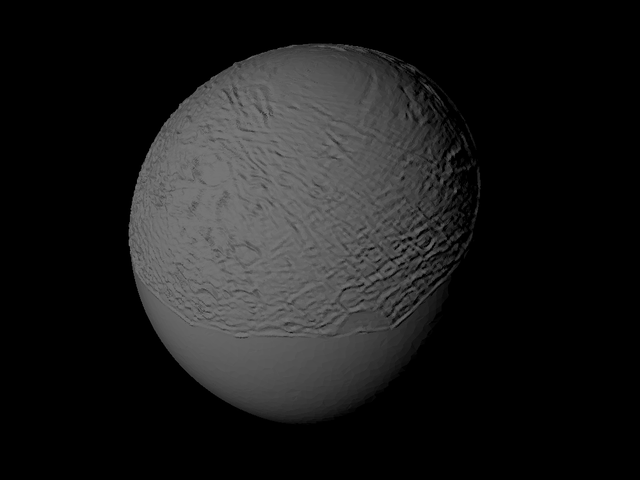
Oberon with approximate topography scaled one in ten million
prusaprinters
<p>Originally published here: <a href="https://www.thingiverse.com/thing:3898006">Oberon with approximate topography scaled one in ten million by tato_713 - Thingiverse</a></p><p>This model is not based on a topographical map, there is not enough good images to make one, this is based on a high contrast polar map from the USGS site, from which the shadows where interpreted as slopes, so the model is something like an integration of the original one in the spherical elevation coordinate. When the Voyager 2 probe reach Uranus, the system where pointing its north pole of rotation to the Sun. Sometimes, because the south pole or the south hemisphere are defined as the one pointing to the south of the <a href="https://www.prusaprinters.org/prints/57301-earth-with-exaggerated-topography-scaled-one-in-si">Earth</a> reference, and the right hand rule north pole is 98° tilted (8 degrees to the south), the then visible part is considered to be the south one. I prefer to follow the right hand rule for all my post, so the mapped parts will be the north ones.</p><p>The file's names explained: <i>name_1_x_10_y.stl</i> is 1 : x* 10^y. So _1_6_10_7 is 1:600000000 or one in 60 million. </p><h3>U4 Oberon</h3><p>Oberon is the second largest, after <a href="https://www.prusaprinters.org/prints/57338-titania-with-approximate-topography-scaled-one-in-">Titania</a>, and the outermost of the big moon of <a href="https://www.prusaprinters.org/prints/57336-uranus-scaled-one-in-250-million">Uranus</a>. It lays outside the magnetic field of the planet, so it's susceptible to the solar winds and the so called space weather. Like all the big moons of Uranus it is composed of equal amount of water and rock, being differentiated into an ice mantle and a rocky core, with a possible liquid water ocean below the surface.</p><ul><li><strong>Type:</strong> Satellite. </li><li><strong>Orbit:</strong> Uranus </li><li><strong>Orbital period:</strong> 13.463 d. </li><li><strong>Composition:</strong> Icy body, differentiated interior, rocky mantle. </li><li><strong>Density:</strong> 1.63 g/cm^3. </li><li><strong>Dimensions:</strong> 1522.8 km. </li><li><strong>Model scale:</strong> 1:1x107 (15cm) 1:2x107 (8cm)</li></ul><h4>References</h4><ul><li><a href="https://astrogeology.usgs.gov/search/map/Oberon/Nomenclature/umbriel_titania_oberon_I-1920_300dpi">https://astrogeology.usgs.gov/search/map/Oberon/Nomenclature/umbriel\_titania\_oberon\_I-1920\_300dpi</a></li><li><a href="https://www.mathworks.com/matlabcentral/fileexchange/4512-surf2stl">Surf to STL function for MATLAB</a></li></ul><h3>Other astronomical objects</h3><p><a href="https://www.prusaprinters.org/social/120859-tato_713/collections/49826">Inner Solar System</a></p><p><a href="https://www.prusaprinters.org/social/120859-tato_713/collections/49832">Artificial</a></p><p><a href="https://www.prusaprinters.org/social/120859-tato_713/collections/49820">Near Earth Asteroids</a></p><p><a href="https://www.prusaprinters.org/social/120859-tato_713/collections/49291">Main Belt Asteroids</a></p><p><a href="https://www.prusaprinters.org/social/120859-tato_713/collections/49829">Jovian System</a></p><p><a href="https://www.prusaprinters.org/social/120859-tato_713/collections/49828">Saturn System</a></p><p><a href="https://www.prusaprinters.org/social/120859-tato_713/collections/49830">Uranian System</a></p><p><a href="https://www.prusaprinters.org/social/120859-tato_713/collections/49345">Neptunian System</a></p><p><a href="https://www.prusaprinters.org/social/120859-tato_713/collections/49827">Centaurs</a></p><p><a href="https://www.prusaprinters.org/social/120859-tato_713/collections/49833">Comets</a></p><p><a href="https://www.prusaprinters.org/social/120859-tato_713/collections/49341">Trans Neptunian Objects</a></p><p><a href="https://www.prusaprinters.org/social/120859-tato_713/collections/49824">Extrasolar Objects</a></p><p><a href="https://www.prusaprinters.org/social/120859-tato_713/collections/49837">Sky Maps</a></p><p><a href="https://www.prusaprinters.org/social/120859-tato_713/collections/49831">Ancient</a></p><p><a href="https://www.prusaprinters.org/social/120859-tato_713/collections/49822">Speculative</a></p><p><a href="https://www.prusaprinters.org/social/120859-tato_713/collections/49821">Science Fiction</a></p>
With this file you will be able to print Oberon with approximate topography scaled one in ten million with your 3D printer. Click on the button and save the file on your computer to work, edit or customize your design. You can also find more 3D designs for printers on Oberon with approximate topography scaled one in ten million.
